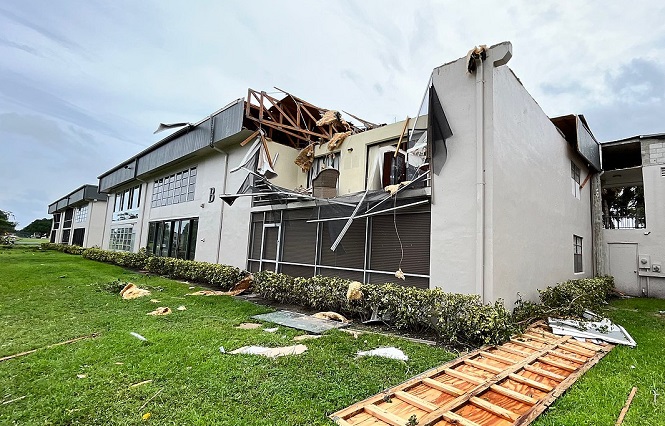BOSTON, Oct. 3 (Korea Bizwire) — Verisk (Nasdaq:VRSK) estimates that insured losses to onshore property for Hurricane Ian will range from USD 42 billion to USD 57 billion. The industry loss estimate from Verisk Extreme Event Solutions includes estimated wind, storm surge, and inland flood losses resulting from Ian’s landfalls in both Florida and South Carolina. The loss estimate excludes certain elements, such as losses to the National Flood Insurance Program and any potential impacts of litigation or social inflation, that could cause the total insured industry loss to exceed USD 60 billion.
Wind damage of USD 38 to 51 billion comprises the majority of the loss estimate. Storm surge (excluding losses from the NFIP) account for USD 3 to 5.5 billion of the loss estimate, and inland flood less than USD 1 billion. Approximately 1 percent of the total industry loss will come from the impacts of Ian’s South Carolina landfall.
Overview of the damage
Wind damage in varying degree was observed in all the areas impacted by Hurricane Ian’s windfield. Damage was more severe in and around the areas where Ian made landfall in southwest Florida. It ranged from significant loss of roof covers in residential homes to torn up roof membranes in commercial structures. Extensive damage is also seen to elements of building components and cladding.
Storm surge also caused massive destruction to communities along the western coast of Florida where Ian made landfall. Residential construction in these areas are predominantly founded on slabs which do not afford a lot of elevation above the local ground surface. Surge damage caused collapse of several rows of beachfront residential homes. In some cases, homes were dislodged from their foundations.
Manufactured homes constitute a significant portion of the residential inventory in southwest Florida when Ian made landfall. Several manufactured home parks in these areas saw massive damage including loss of roofs, damage to wall siding and near total destruction.
What’s included in Verisk’s estimate
Included in the estimate are losses to onshore residential, commercial, and industrial properties and automobiles for their building, contents, and time element coverage. The estimate reflects the impacts of inflation on labor and materials over the past two years, as well as the effects of demand surge, when large numbers of property owners look to rebuild at the same time.
Verisk’s modeled insured loss estimates do not include:
- Losses to inland marine, ocean-going marine cargo and hull, and pleasure boats
- Loss adjustment expenses
- Losses exacerbated by litigation, fraudulent assignment of benefits, or social inflation
- Losses paid out by the National Flood Insurance Program
- Storm surge leakage losses paid on wind-only policies due to government intervention
- Losses to uninsured properties
- Losses to infrastructure
- Losses from extra-contractual obligations
- Losses from hazardous waste cleanup, vandalism, or civil commotion, whether directly or indirectly caused by the event
- Losses resulting from the compromise of existing defenses (e.g., natural and man-made levees)
- Other non-modeled losses, including those resulting from tornadoes spawned by the storm
- Losses for U.S. offshore assets and non-U.S. property
How the hurricane unfolded and broke records
Heavy rain, storm surge, and tropical storm conditions began across portions of southwest Florida late Tuesday afternoon. Overnight Ian slid past the Florida Keys. Despite receiving a glancing blow from Ian, Key West recorded its third-highest storm surge since 1913 at just over 3 feet and peak wind gusts into the upper-60s mph.
Conditions deteriorated rapidly in western Florida as Wednesday morning progressed, with heavy rainfall spreading northward and major-hurricane-force winds from Ian’s eyewall coming onshore late morning near Fort Myers Beach and Sanibel Island. To the south, in Naples and surrounding areas, Ian’s powerful winds were oriented perpendicular to the coast, which exacerbated the water inundation caused by storm surge as water from the Gulf was effectively blown inland. As a result, Naples saw over 6 feet of catastrophic storm surge, shattering the previous record.
Ian officially made landfall at Cayo Costa, Florida at 3:05 PM local time as a Category 4 hurricane with maximum sustained winds of 150 mph. Around this time, a 124-mph wind gust was observed in Punta Gorda before the station failed. Ian then slowly proceeded inland, following a northeasterly track that led the storm’s massive 30-mile-wide eye (wider than the east-west extent of Lake Okeechobee) over Gasparilla Sound and Punta Gorda.
Owing to the storm’s slow motion, areas like Port Charlotte and Englewood remained in Ian’s eyewall for several hours; this resulted in 18 – 20 inches of rainfall in addition to prolonged exposure to the powerful wind gusts located in Ian’s northwestern eyewall. Ian managed to stay about 65 miles southwest of Tampa, which owing to Ian’s large wind field was still close enough to bring wind gusts into the upper-70s mph and 2 – 5 inches of rainfall; before that, Tampa Bay was temporarily drained of water because of inverse storm surge from Ian.
On Thursday morning, Ian moved off the Atlantic coast near Cape Canaveral – a bit further south than previously expected. As Ian moved back over the ocean on Thursday, conditions were favorable enough for some additional strengthening and Ian was upgraded to a hurricane as of Thursday evening.
Ian made a second landfall on Friday afternoon at 2:05 pm EDT near Georgetown, SC as a mid-range Category 1 hurricane with maximum sustained winds of 85 mph. Heavy rainfall and strong gusty winds of more than 50 mph impacted portions of the Carolinas. With these impacts ongoing, Ian was officially declared post-tropical at 5pm as the center moved into northeast South Carolina.
Hurricane Ian brought significant storm surge damage to southwest Florida, to both residential and commercial exposures. However, the flood insurance take-up on residential risks in Florida are low.
About Extreme Event Solutions at Verisk
Extreme event solutions at Verisk provides risk modeling solutions that help individuals, businesses, and society become more resilient to extreme events. In 1987, Verisk founded the catastrophe modeling industry and today models the risk from natural catastrophes, supply chain disruptions, terrorism, pandemics, and casualty catastrophes. Insurance, reinsurance, financial, corporate, and government clients rely on Verisk’s advanced science, software, and consulting services for catastrophe risk management, insurance-linked securities, longevity modeling, site-specific engineering analyses, and agricultural risk management. Verisk’s extreme event solutions team is headquartered in Boston, with additional offices in North America, Europe, and Asia. For more information, please visit www.air-worldwide.com. For more information about Verisk, a leading data analytics provider serving customers in insurance, energy and specialized markets, and financial services, please visit www.verisk.com.
###

For more information, contact:
Mary Keller
Verisk Extreme Event Solutions
617-267-6645
Mary.Keller@verisk.com
Source: Verisk Extreme Event Solutions via GLOBE NEWSWIRE








